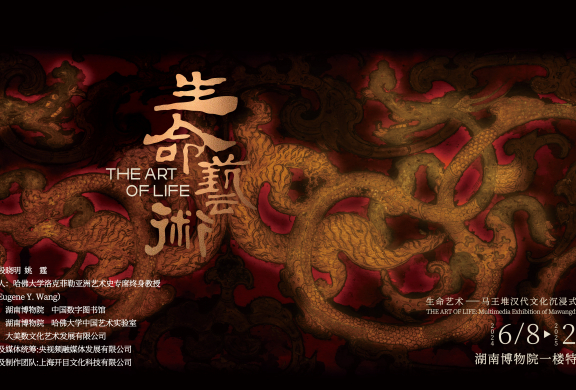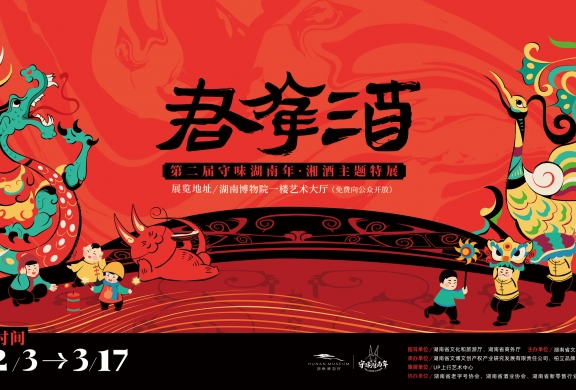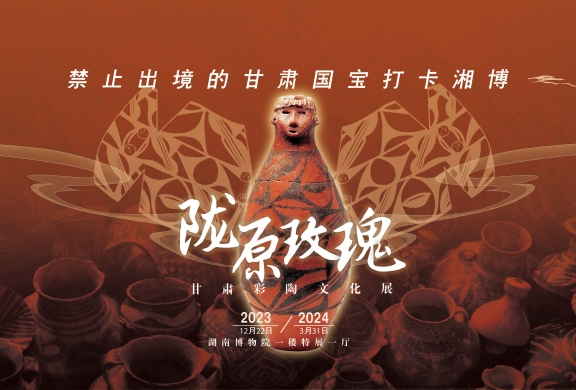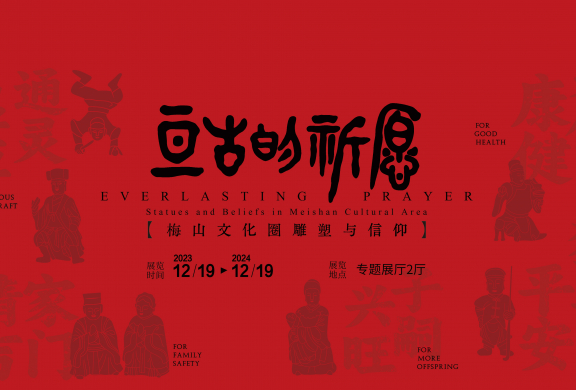Past Exhibitions
The Art of Life:Multimedia Exhibition of Mawangdui Han CultureNo.1 Special Exhibition Hall, 1st F 2024.06.08 - 2025.05.18 2024 marks the 50th anniversary of the archaeological excavation of the Mawangdui tombs. The discovery of Han Dynasty tombs astonished the world, demonstrating the splendid culture and profound thoughts of early Chinese civilization. The Mawangdui tombs carries the grand imaginations and artistic expressions of ancient China on the universe and life. After half a century of research and organization, this grand exhibition will use the most cutting-edge academic research results and scientific and technological means to deeply interpret the tombs art through immersive digital displays, presenting to the global audience the fascinating stories embedded in this compelling cultural heritage. We look forward to bringing an inspiring and powerful cultural experience to the audience, so that the ideological and artistic charms of the Mawangdui tombs will continue to shine brightly, connecting with the world across time and space. “The Art of Life:Multimedia Exhibition of Mawangdui Han Culture” is presented by the Hunan Museum and the Digital Library of China, in collaboration with Professor Eugene Wang’s team from the Harvard FAS CAMLab. This exhibition integrates global academic resources and the latest insights on Mawangdui Han culture and early Chinese civilization, bringing the audience into the imaginative journey of life’s transformation embodied by the Mawangdui tombs. Utilizing cutting-edge multimedia technologies such as ultra-high-definition artifact scanning, 3D projection, generative algorithmic art, and immersive LED spheres, it offers an immersive experience of early Chinese cosmology and the imagination of life’s transformation. |
The Flavor of Hunan ⅡArt Hall, 1F 2024.02.03 - 2024.03.17 “The Flavor of Hunan Ⅱ” delves into the cultural artifacts related to liquor in the Hunan Museum. It combines local liquor customs, liquor culture, and liquor brands of Hunan Province. Through three perspectives — historical humanities, geographical conditions, and liquor customs — it interprets the profound history and tradition of Hunan liquor, its rich artisan culture, abundant revolutionary history, diverse cultural heritage, and intangible cultural legacy. The exhibition is divided into four major sections, including "Liquor Culture in Hunan Museum" "Brewing Fine Liquor in Hunan" "Brewing Techniques," and "Fragrant Bistro". Through a sensory experience that engages sight, hearing, smell, taste, and touch, it guides the audience to appreciate the charm of Hunan liquor culture. |
Youth is Meant for Striving: An Exhibition of Youthful Mao Zedong’s Cultural RelicsThemed Exhibition Hall, 3F 2024.01.30 - 2025.01.30 Over the past century, with every forward stride of the era, the figure of the youth has been reflected, promoting the victory with their beliefs, suppressing the turbulence through diligence, and composing the anthem of the times with their youth. Youthful Mao Zedong harbored lofty ideals, sought knowledge, tempered revolutionary skills, pursued truth, courageously undertook the mission of national rejuvenation, and harmonized knowledge with action, awakening the masses of workers and peasants. Confronting difficulties directly, he dared to struggle and advocated for striving. This exhibition, centered around time, carefully selects over 150 exhibits from the Hunan Museum, Changsha Museum, Mao Zedong and the First Normal School Memorial Hall, and Hunan Provincial Archives. It showcases the journey of young Mao Zedong from studying at the normal school to leading the movements of workers and peasants, narrating his exemplary influence in cultivating moral character, establishing lofty ideals, loving the great motherland, and shouldering the responsibilities of his era. |
Longyuan Rose-The Exhibition of Painted Pottery in Gansu ProvinceNo.1 Special Exhibition Hall, 1F 2023.12.22 - 2024.03.31 Ancestors in the Gansu province took nature as basis, selected plants, animals, rivers and other natural objects in the nature as the source of creation. Through the expression of dots, lines and planes, they not only created vibrant and charming patterns on potteries, such as plant pattern, animal pattern, swirling pattern and geometric pattern, combining with human beings, they also created dance pattern, gods and men pattern which are rich in thoughts. The flamboyant and bold red and black, painting the sun, moon and stars, painting all living things, painting what were seen and thought, from depicting the shape to the full nature of objects, the naive stroke from straight lines to curves, from pictogram to geometric, from realism to ideogram, which are the origin of the great beauty of China. The painted pottery in Gansu province is the origin of the ornamental art in China, its colorful, simple and bright, bold and flexible features have left a strong mark in the history of Chinese art. In this exhibition, 210 pieces of Neolithic painted pottery from Gansu province are specially selected, including representative artifacts spanning 5000 years from the Dadiwan culture period to the Shajing culture period. Through the interpretation of various types of decorations on the painted pottery, the exhibition shows the changes in the aesthetic tastes of the ancestors, the advancement of knowledge and concepts, interprets the relationship between human beings and the natural environment, and then analyzes the initial features of the primitive religious beliefs and the formation of abstract symbols, aiming at tracing the childhood memories of the Chinese nation, and providing the deep driving force from the cultural genes for the success of the story of China. |
Everlasting Prayer:Statues and Beliefs in Meishan Cultural AreaNo.2 Themed Exhibition Hall, 3F 2023.12.19 - 2024.12.19 With the collision and fusion with other cultures, Meishan culture has evolved into a cultural form that flows with the genes of the Southern Chu(was a Zhou dynasty vassal state) culture, but also blends elements of Taoism, Buddhism, Confucianism and the influence of other ethnic groups in the south. Meishan culture is not only a cultural phenomenon in the Meishan region of central Hunan in ancient times, but also a living culture that has been inherited to the present day, and is a typical representative of the cultural practices of many ethnic minorities such as Yao and Miao in southwest China. Ancient pre-Qin Hunan realm, is the location of barbarian tribes such as "Jiu Li" "Three Miao". During the Spring and Autumn and Warring States Periods, the Chu people went to the south of China, and in this fertile land of myths, beliefs and sorcery, the magnificent and brilliant Chu witch culture in the South was nurtured and grown. The Chu culture was gradually assimilated by the dissolution of the Central Plains culture, but the original beliefs of the Chu deities and sacrificial customs were preserved in the ancient Meishan area, which is "not connected with the outside world". The objects of worship may have changed, but the primitive, instinctive and simple desire to seek good fortune and avoid bad luck in real life constitutes the eternal spiritual treasure of the folk beliefs of the Meishan Cultural area. By selecting more than 100 pieces of wood carvings and archaeological relics from the Hunan Museum and related institutions in the central Hunan province since the Ming and Qing dynasties, this exhibition shows the origin and basic features of folk beliefs in this cultural area, with a view to leading the audience to appreciate the cultural forms with unique local characteristics of Hunan and stimulating the audience to think about historical and cultural inheritance, cultural diversity, and the perception of life. This exhibition, as part of Hunan Museum's "Hunan Culture" exhibition series, "Treasures Revisited--Hunan Museum's 'Discovery Series' Original Thematic Exhibitions", was awarded the State Administration of Cultural Heritage's "Carrying Forward the Outstanding Traditional Chinese Culture and Cultivating the Socialist Core Values" Thematic Exhibitions Recommendation Project for the year 2023. |
The Greeks:From Agamemnon to Alexander the GreatNo.2 Special Exhibition Hall, 1F 2023.12.18 - 2024.05.18 Traveling through history, we sincerely eulogize "Glory to Greece". The ancient Greeks drew on the essence of Egyptian civilization as well as the Two Rivers civilization, and under the distinctive natural geography and human background of the Aegean Sea region, they created a regional culture that is remarkable in the history of mankind, and from which the whole of European civilization was nurtured. Moreover, up to the present day, the progress and development of Europe, western society and even the world are still absorbing the rich nutrients of ancient Greek civilization. The exhibits come from 14 museums and cultural institutes in Greece, a total of 270 pieces/sets, including gold ware,bronze ware, porcelain and sculptures, spanning a period of 7000 years. These treasures is in the form of physical evidence to show the ancient Greek civilization since prehistory to the "Hellenistic" era of the beginning of the political, economic and cultural landscape. “Splendid civilization owing to communication, rich civilization giving to mutual understanding”, let us enter this cultural feast together, enjoy the epic grandeur of ancient Greek civilization, roam in the rippling Aegean Sea, deeply understand the diversity and commonality of civilizations, and appreciate the important meaning of the human destiny. |








